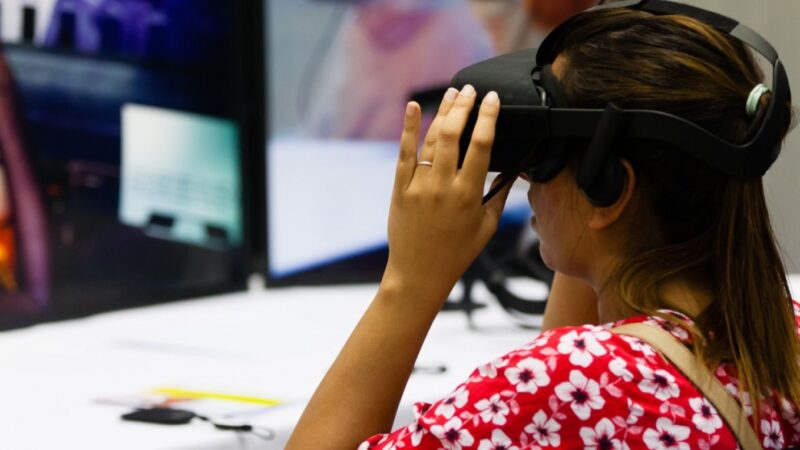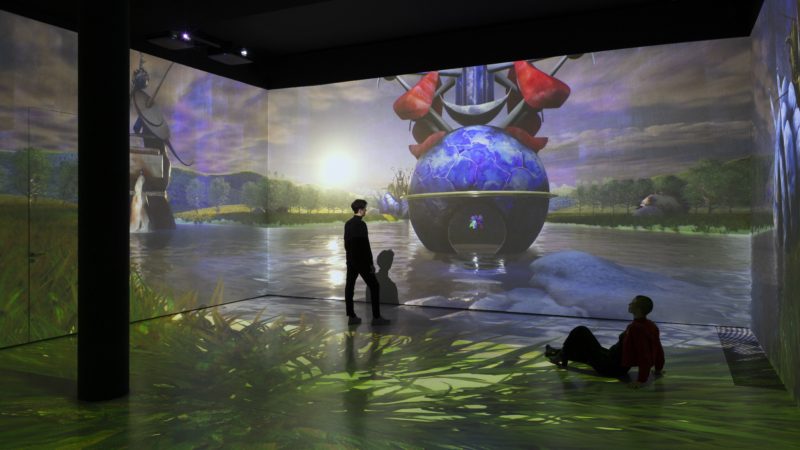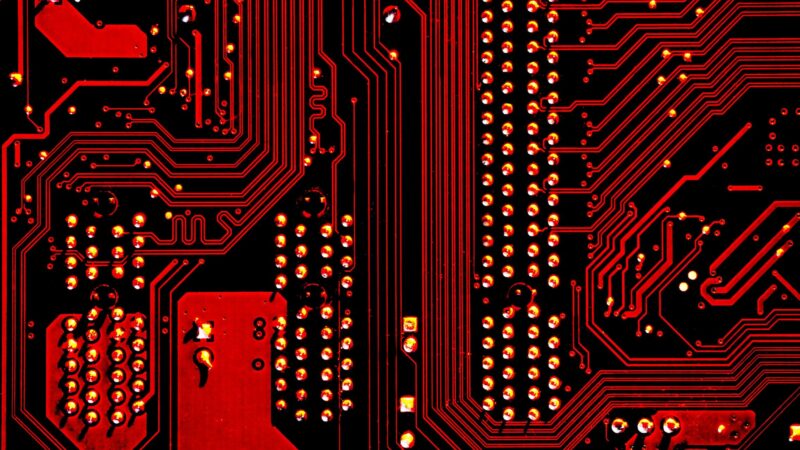Artificial Intelligence is increasingly discussed and part of our everyday lives, but what role could it play in creative expression, arts and culture? A while ago, The Space brought practitioners, experts, and audiences together to explore how Artificial Intelligence can be a tool for us all.
“Almost daily now, there tend to be articles written about the ethos and the ethics of what AI might mean for us as a society,” says Fiona Morris, Creative Director and Chief Executive of The Space, “and it varies from the kind of apocalyptic to some nirvana.”
“There is a real requirement for artists in the cultural sector to respond to AI, embrace it, understand it –– and be able to tell stories about it,” she says. “Yet I didn’t feel I had seen much in the way of really practical tools for artists to go ‘that’s what Artificial Intelligence does’.”
Artificial Intelligence and the cultural sector
Instead, if we are conscious of AI then it tends to be via products which adapt to how we use them, such as ‘connected home assistants’ Google Home, Apple Siri or Amazon’s Echo smart speakers, otherwise known as Alexa. These products use language to provide us with a service, building knowledge of our preferences the more we interact with them.
The wider applications of Artificial Intelligence and Machine Learning are not always visible, yet they are already deeply embedded in the way technology firms work. Could the arts and cultural world show us all what AI could actually mean, what it really does, and what we can truly use it for?
The “Next Generation Storytelling: AI and Language” one-day event in Manchester aimed to demystify Artificial Intelligence and give creative practitioners inspiration and insight in how it could be used, with a focus on the intersection of language and AI. The Space brought speakers from the US, Canada and the UK together with an audience of theatre makers, musicians, writers and AI practitioners.
Ross Goodwin, whose ‘Road Trip’ novel “1 the Road” was created using a portable AI writing machine as he drove across America, helped curate the day. Ross describes himself as an ‘artist, creative technologist, hacker, gonzo data scientist, writer of writers’ and his work is focused on the intersection of language and technology. 1 The Road was followed by Please Feed the Lions, an interactive Lion sculpture in Trafalgar Square by artist Es Devlin, commissioned by the London Design Festival, Google Arts & Culture and The Space, which used a deep learning algorithm developed by Ross to allow the public to input words to create new ‘poetry’. This is also where Ross first worked with The Space. In fact, it was the use of language and the response of audiences in this work that inspired the team at The Space to want to explore this area more.
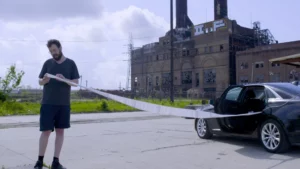
Artist and researcher Luba Elliott, who has curated AI cultural festivals including ART.AI, and advised Google and Samsung on the use of AI, and artist Libby Heaney, whose AI work includes artificial conversations, chatbots, for Sky Arts, joined the line-up. The Space also invited Pietro Gagliano, a director and filmmaker based in Toronto, who is developing a film commissioned by the National Film Board of Canada about AI creatures who become characters we begin to care for.
Goodwin says that the group, and especially The Space’s plans for the day, were “right up my alley”.
What is the perception of AI?
“I really like spreading the information virus about AI not being what people think it is,” he continues. “I think the whole perception is largely based on science fiction. And the public tend to conflate science fiction notions of artificial intelligence with reality. The main problem with that, in my opinion, is that when artificial intelligence appears in science fiction, it’s usually a stand-in for working class labour. The word ‘robot’ quite literally means ‘slave’ in Czech.”
“The name AI, unfortunately, creates a myth around it,” says Libby Heaney. “‘Artificial Intelligence’, it’s really just complicated statistics. I see it as a tool and you do still need some technology knowledge. But there’s always this period where people use technology initially, it dies down, and then it becomes more widespread. Like video art which in the Sixties was quite niche and new, and now everybody makes video art.”
Heaney has used AI to create Lady Chatterley’s Tinderbot, an interactive touch screen artwork comprising conversations between an AI Tinderbot posing as characters from DH Lawrence’s Lady Chatterley’s Lover and other Tinder users.
Like all Heaney’s art, and most of the work discussed on this day, it starts with a dataset. She took all of the dialogue from the novel and around 800 anonymised Tinder conversations and designed an algorithm that would quote the most relevant lines in response to her audience’s messages, with help from Bernie.ai ‘your personal matchmaker A.I.’
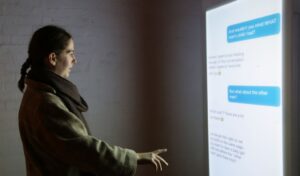
Throughout the day, an issue that came up repeatedly was how AI always uses this dataset idea. Poetry apps are trained by being loaded with existing poems that they then look for patterns in, for instance.
Can anything truly new come from AI?
A question put forward by audience members was that when art is based solely on existing work, it means AI must be derivative, that nothing new can come of it.
“Is anything ever new and not derivative?” responds Luba Elliott. “As humans, if you’re a writer, you go to school, you read a lot of books, and that becomes part of your own dataset. Your brain with its own algorithm, processes this and you write whatever you want, but consciously or subconsciously, it will be influenced by what you read.”
“It is different with AI,” she continues, “because a machine only sees a reservoir, [the data you’ve chosen to give it], AI doesn’t experience the childhood of a writer or the different kinds of experiences that you’ve had. But there is also always the role of the artist [using this AI tool]. They have a lot of influence through the dataset they pick, the algorithms they choose.”
Subverting AI – finding ways to mis-use it
If Elliott sees the principle of AI being influenced by what it knows as being the same as the way we all work, Heaney likes to deliberately subvert the technology to show up these issues.
“The main thing I’m interested in as an artistic practitioner, purely in terms of storytelling, is how you can actually mis-use AI,” she says, “in order to create expanded storytelling, expanded narratives on certain topics as opposed to following canonical, standardised narratives.”
One of her pieces is Britbot, an online conversation that asks the audience about Britishness and through that explores identity. Heaney took as her dataset the UK citizenship test, which she says “is a horribly biased version of British history and culture.”
For Heaney, the citizenship test is this official process which appears to be formal and proper, but really betrays the startling biases and prejudices of the people who created it.
“I used AI and audience participation to disrupt it,” she says. By taking parts of the test and having her AI algorithm discuss it with her audience, she hopes she illuminates those biases and gets us debating them.
“So for me it’s about how you can misuse these tools in a productive way to really be creative with them instead of just copying reality as the big tech companies do,” she says.
Technology firms are, unsurprisingly, ahead of artists in their use of technology, but this idea of an enormous issue being understood by only a small group has some parallels with the past.
“Twenty years ago,” says Fiona Morris, “scientists had the evidence of climate change but they weren’t able to communicate it in a way that ordinary people could grasp and take into their lives. I think the arts community did a lot to humanise it and to tell stories with it.”
“We’re at a similar point now,” she continues, “where AI is the kind of technology that will change all of our futures, potentially for better or worse, and it is complicated.”
Harnessing the power of AI in filmmaking
Film director Pietro Gagliano is currently deep into production on a virtual reality story where behind the scenes, the technology is pushing at the limits of what AI can do now. But which is also a profoundly human endeavour. His story, Agence, is about AI creatures living on an imaginary planet that the audience tends (looks after) for, as in a game. The audience can influence what happens to the creatures and even in the brief moments shown on The Space’s day, we begin to care what happens to them.
“I wanted to convey that people who are involved in the arts and the entertainment space can participate in this amazing technology. That we shouldn’t just be consumers of it, we should be creators as well,” he says.
Gagliano agrees that AI is going to change everything and that we need to grasp it as artists and practitioners.
“It might be a tough transition,” he says, “but to me, AI is a tool that is going to disrupt the arts and entertainment space fundamentally. I’d like to think that it’s the artists who aren’t afraid of their creativity being challenged who are going to embrace it first. And artists who will see it as wow, this is a new tool, it’s going to challenge me creatively, it’s going to make me even more creative than I already am. Not, ‘this thing’s going to steal my job’.”
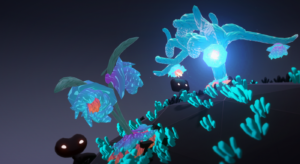
How useful was this resource?

